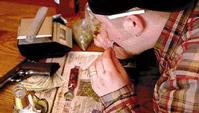By Eulalee Thompson, Staff Reporter 
Local researchers are concerned about a link between drug abuse and other violent and risk-taking behaviour in the society - National Survey of Drug Use & Abuse in Jamaica, Hope Enterprises Limited.
BEING AN unemployed, poorly-educated young man are strong risk factors in the abuse of alcohol and other legal and illicit substances.
Those who are interested in "the men at risk theory" would be interested to note that in the recently-published National Survey of Drug Use and Abuse in Jamaica, the researchers found not only a strong association between heavy alcohol consumption and being male 18 to 24 years but also that these young males were more likely to abuse tobacco, ganja, cocaine, crack, heroin, ecstasy though the general usage of the hard drugs was low in the population.
Carole Gayle, researcher and project director of Hope Enterprises Limited, the agency which conducted the survey, indicates that men are three times as likely as females to abuse or be dependent on alcohol or other drugs and young adults 18 to 24 years were most likely to have drug or alcohol problems. Nearly 21 per cent of the 18 to 24 year olds report ever using tobacco; nearly 61 per cent of them report ever using alcohol; two per cent of them indicate a dependency on alcohol and nearly 27 per cent of them have ever used an illicit drug (ganja, crack, ecstacy, inhalants, cocaine, heroin). Adolescents (those aged 12 to 17 years) were least likely to abuse drugs.
In explaining the size of the country's drug abuse problem among young people at the recently-held research conference hosted by the National Council on Drug Abuse (NCDA), Miss Gayle pointed out that 12.6 per cent of 18 to 24 year olds compared to 7.1 per cent of 12 to 17 year olds had drug-related problem (both legal and illicit drugs). The use of illicit substances peaked in the 18 to 24 year age group at 16. 9 per cent.
The young people indicated that their major sources of illicit drugs were drug sellers and dealers, friends, bars and nightclubs, parties and from students and school.
Miss Gayle said that alcohol was too readily available and that this availability was contributing to the under-age drinking problem. Most of the children under 17 years said that it was easy to obtain alcohol mainly when they went to parties, at bars and shops, from friends and even at home. The researchers indicate that the country would probably benefit from legislation to control the sale and distribution of alcohol to minors.
The researchers were also concerned about a link between drug abuse and other violent and risk-taking behaviour in the society. They, in fact, were able to gather data indicating a connection between drug abusers and involvement in quarrels and fights and casual, unprotected sexual encounters. They could not underscore any more clearly the importance of the use of this data in efforts to control rampant violence in some communities and the spread of sexually-transmitted diseases.
ABOUT THE STUDY
The sample was selected to represent the national population statistics by using a multistage stratified random sampling technique to select eight enumerated districts which were then used as sampling clusters from which all eligible individuals between the ages 12 and 55 years within all households were interviewed.
The sample size was 2,380.
The youth sample was 12 to 17 years : 529; 18 to 24 years : 502.

